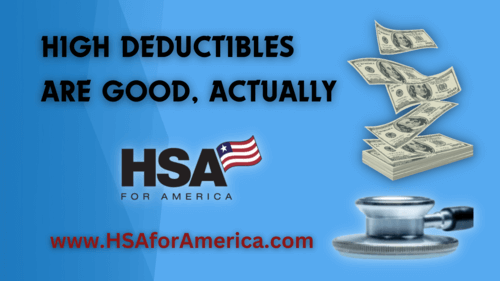With high deductible health plans, nobody likes paying out of pocket for health care costs. But that’s what deductibles require you to do: share in the cost of your medical care by paying the first few hundred or thousand dollars in the event you need care during the year.

High Deductible Health Plans
As of late 2023, the average deductible for a self-only policy in the individual market was $2,825.
That’s quite a hurdle when you consider that more than half of American households can’t absorb an unexpected $1,000 bill without going into debt.
So a high deductible plan might not be a great match if you can’t afford to see the doctor.
But if you have some assets on hand, and you can afford your deductible, if need be, and you’re currently in good health, a high-deductible health plan or even a catastrophic-only health plan may be worth considering.
When it comes to health insurance, higher deductibles have a number of both individual and societal benefits.
First, we’ll discuss the multiple societal benefits of higher deductibles and higher medical cost sharing.
Then we’ll boil things down to “what’s in it for you:” and discuss the potential benefits of a higher-deductible health plan for you and your household.
Societal Benefits of Higher Deductible Health Plans
At the societal level, high deductibles mean consumers shopping for health care have more “skin in the game” compared to people in very low deductible plans.
This leads to multiple economic and societal benefits:
- Increased individual responsibility. People with high-deductible health plans are more likely to shop around for the best prices and services, which can lead to lower healthcare costs overall.
- Reduced moral hazard. Moral hazard occurs when people take on too much risk because they know they are protected by insurance. High-deductible health plans can help to reduce moral hazard by making people more aware of the costs of healthcare and encouraging them to make more responsible decisions about their health.
- Increased efficiency. High-deductible health plans can lead to more efficient use of healthcare resources. When people have to pay more out-of-pocket for their care, they are more likely to use only the services that they need.
This can help to reduce waste and improve the quality of care.
When large numbers of people share more in the cost of providing healthcare, it tends to foster competition among healthcare providers, and ultimately more efficiency and lower costs for everyone.
Compare Pricing on the Best Insurance Plans Available
How Higher Deductible Plans May Benefit You
Broadly speaking, there are three types of higher-deductible plans that can help you save money if you’re in good health.
Each of them have advantages and disadvantages. But if you’re able to absorb a few thousand dollars a year in deductibles and other out-of-pocket costs, one of these types of plans is probably worth serious consideration.
1. Health Savings Account (HSA)-qualified high-deductible health plans (HDHPs)
These plans have high deductibles, but they also allow you to contribute money to a health savings account (HSA). HSAs are tax-advantaged savings accounts that you can use to pay for medical expenses.
Under the Affordable care Act, health plans must meet these criteria to be HSA qualified, as of 2024:
- Deductibles must be a minimum of $1,600 for self-only coverage and $3,200 for family coverage.
- Maximum out-of-pocket expenses (not counting premiums) cannot exceed $8,050 for individual coverage and $16,100 for family coverage.
- High-deductible health plans must also cover a minimum set of essential health benefits. These include preventive care, doctor’s visits, hospital stays, prescription drugs, and mental health services.
2.) Health sharing plans
Health sharing is a non-profit, community-based alternative to traditional health insurance products.
These plans are typically up to 50% less costly than traditional health insurance plans without an Obamacare subsidy. But they also have some different features and requirements.
They don’t qualify for an ACA subsidy. And they typically impose a waiting period of several years before they will share the cost of treating pre-existing conditions.
But if you are in good health with no pre-existing conditions, and you earn too much to get an Obamacare subsidy, these plans can be a great match.
Learn More: JHS Community Healthshare: The Best Catastrophic Health Share Plan On The Market
3.) Catastrophic-only health insurance plans
These plans have very high deductibles, but they also have very low monthly premiums. Catastrophic plans are designed for people who are healthy and don’t expect to need a lot of medical care.
To sign up for a catastrophic health plan, you must be under the age of 30, or qualify for a hardship/affordability exemption.
These plans can be a great solution if you are under 30 and in very good health, with no preexisting conditions, and no expectation of having to see a doctor any time soon.
However, if you do need care, you will need to pay thousands of dollars out of pocket before your plan will start to pay benefits.
These plans also don’t qualify for an Affordable Care Act subsidy.
Learn More About Catastrophic-Only Health Insurance
Combining HDHPs and HSAs
High deductible health plans are meant to be combined with health savings accounts.
Combining these two vehicles can generate some significant savings. Here’s how:
1. Immediate premium savings
According to KFF data, the average subsidized high deductible health plans (HDHPs) cost just $95 a month for an individual plan and $393 for families. In contrast, standard deductible plans have average premium contributions of $110 and $525, respectively.
That means the average family stands to save $1,524 in premiums each year just by switching to an HDHP.
Your HSA contributions aren’t lost; anything you contribute to an HSA is available for you to buy qualified medical products and services tax-free. That saves you between 20% and 40% in healthcare costs right there, compared to paying them out of pocket.
2. Tax savings
But the benefits don’t stop there. HSAs can help you save a significant amount in taxes
.By enrolling in an HDHP, and meeting certain other eligibility criteria, you and your family can contribute up to $8,300 per year in pre-tax dollars to a health savings account as of 2024.
HSAs enjoy the most favorable tax treatment of any tax-favored savings vehicle in the U.S. tax code available to individuals. They offer a triple tax benefit:
- HSA contributions are pre-tax.
- Assets grow tax-deferred as long as they remain in the health savings account.
- Withdrawals to pay for qualified medical expenses are tax-free.
Example: Suppose you’re in the 25% tax bracket, and you contribute the maximum allowed by law for a family. In 2024, contributing the maximum ($8,300) can reduce your federal income tax liability by an additional $2,075.
This is a significant benefit right there: if you never need medical treatment, you still save over $1,600 per year just in immediate first-year tax savings alone, based on the 25% tax bracket.
If you’re self-employed or over age 55, you can save even more.
Click Here to Learn More About Health Savings Accounts and HDHPs
HSAs: A Valuable Retirement Asset
Think of your HSA as a stealth retirement account
After age 65, you can use the funds for any purpose you like. The usual 20% penalty for non-qualified withdrawals goes away, though you’ll pay income tax on withdrawals not used for qualified medical expenses, just as you would with a traditional IRA.
Meanwhile, unlike IRAs, HSAs have no required minimum distributions. So you can let your HSA assets compound for as long as you like, or use them to pay tax-free for Medicare deductibles, co-pays, qualified long term care insurance premiums, and any other qualified medical expense.
Learn More: Up Your HSA Game With These Three Investing Strategies
Compare Pricing on the Best HealthShare Plans Available
HSAs Provide More Control Over Your Healthcare
With an HSA, you’re in the driver’s seat.
You decide how much to contribute (up to the annual limit), how to spend it, what doctors to spend it with, and even where to invest it. Yes, you read that right—you can invest your HSA funds in stocks, bonds, and mutual funds, potentially growing your healthcare nest egg even more.
All these opportunities open up to you because you choose to participate in a little more of your own costs of care by opting for a high deductible health plan.
Questions? We’re Here to Help!
Yes, that’s a lot of information to take in at once.
The good news is, you don’t have to make the decision alone.
That’s why we have a highly-trained team of Personal Benefits Managers available to help guide you.
If you have any questions, or you want some help walking through the different options available to you, getting help is easy and hassle free. Just, make an appointment with an HSA for America Personal Benefits Manager for a free 1:1 consultation.
Your PBM can provide personalized assistance to help you make the best decisions for your overall healthcare strategy.
Learn More: Combining HSAs with Health Sharing Plans With HSA MEC | Best Health Share Plans Comparison Guide 2025 | Up Your HSA Game With These Three Investment Strategies | What is a Deductible in Health Insurance?



